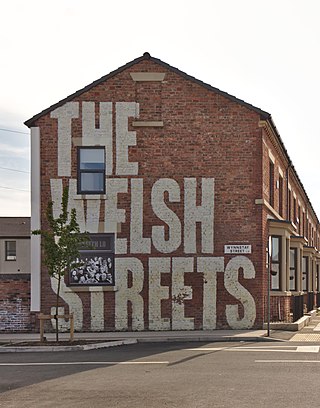
Toxteth is an inner-city area of Liverpool in the county of Merseyside.

New Ferry is an urban area on the Metropolitan Borough of Wirral, Merseyside, England. It is located on the Wirral Peninsula, with the River Mersey to the east and the town of Bebington to the west. Within the boundaries of the historic county of Cheshire, the area was developed from the early nineteenth century.

The National Lottery Heritage Fund, formerly the Heritage Lottery Fund (HLF), distributes a share of National Lottery funding, supporting a wide range of heritage projects across the United Kingdom.

The Church and Friary of St Francis, known locally as Gorton Monastery, is a Grade II* listed former Franciscan friary in Gorton, Manchester, England. It was designed by the noted Victorian architect Edward Welby Pugin and built 1866–1872. Gorton Monastery is a noted example of Gothic Revival architecture.

Wilton's Music Hall is a Grade II* listed building in Shadwell, built as a music hall and now run as a multi-arts performance space in Graces Alley, off Cable Street in the London Borough of Tower Hamlets. It is one of very few surviving music halls of the East End of London and retains many original features.
'Stop the Rot' is a campaign launched in October 2000 by the Liverpool Echo newspaper with the aim of rescuing and preserving the rich architectural heritage of Liverpool and the greater Merseyside area. The campaign was launched when part of the Casartelli Building in Hanover Street in Liverpool collapsed, and this building subsequently became the symbol of the campaign.

The Wedgwood Institute is a large red-brick building that stands in Queen Street, in the town of Burslem, Stoke-on-Trent, Staffordshire, England. It is sometimes called the Wedgwood Memorial Institute, but it is not to be confused with the former Wedgwood Memorial College in Barlaston. It achieved listed building status in 1972.
The Belfast Buildings Trust (BBT), founded in 1996 as the Belfast Buildings Preservation Trust, is a cross-community building preservation trust with charitable status that delivers physical, social, and economic regeneration through the reuse of landmark buildings in Belfast, Northern Ireland.

The Horseboating Society is a national society, with the primary aim being the preservation and promotion of Horseboating on the canals of Great Britain. The Society was founded on 19 January 2001 at the Ellesmere Port Boat Museum, and it is the only organisation in the UK solely dedicated to horseboating.
Malcolm Fraser is an architect from Edinburgh, Scotland. He was the founder of Malcolm Fraser Architects, a firm of architects based in the Old Town of Edinburgh from 1993. The company entered liquidation on 21 August 2015 and Fraser worked with Halliday Fraser Munro Architects before setting up anew with Robin Livingstone as Fraser/Livingstone Architects in January 2019.

The Welsh Presbyterian Church is a disused church on Princes Road in the Toxteth district of Liverpool, Merseyside, England. It is a redundant church of the Presbyterian Church of Wales, and is recorded in the National Heritage List for England as a designated Grade II listed building. Because of its tall steeple, the church has been nicknamed the "Welsh Cathedral", or "Toxteth Cathedral", although it was never an actual cathedral. In 2019, it received National Lottery Stage 1 funding to become a community hub after thirty years abandonment.

Page\Park Architects is a Scottish architectural company established in 1981, by David Page and Brian Park.
The Architectural Heritage Fund (AHF) is a registered charity founded in 1976 to promote the conservation and re-use of historic buildings across the United Kingdom. The AHF provides communities with advice, grants and loans to help them find enterprising and sustainable ways to revitalise the old buildings they love, particularly in economically disadvantaged areas. For over 40 years, it has been the leading social investor in creating new futures for historic buildings.

van Heyningen and Haward is an architectural practice, founded in 1983 by Birkin Haward and Joanna van Heyningen, and now owned and managed by James McCosh and Meryl Townley. The London architects work primarily in education, and have also worked in the heritage, community and health sectors.

Middleport Pottery was built in 1888 by Burgess & Leigh Ltd. It is located at Middleport, Stoke-on-Trent, England. The buildings, which still house an active pottery, are protected for their historic interest. Middleport Pottery is owned and operated by Re-Form Heritage.

The Welsh Streets are a group of late 19th century Victorian terraced streets in Toxteth, Liverpool, England. The houses were designed by Welsh architect Richard Owens and built by Welsh workers to house workers mainly involved in the industries on the docks; the streets were named after Welsh villages and landmarks. The Beatles drummer Ringo Starr lived the first few years of his life in Madryn Street. Although some original houses were lost in World War II bombing, many of the terraced properties in the original street configuration remain in the present day.

The Bridgend Farmhouse Community Project in Edinburgh, Scotland is a community-owned and community-run charitable organisation. The project restored an 18th-century farmhouse to provide a community meeting place, café, garden and workshops. The project runs classes, workshops and training courses in a variety of crafts and skills aimed at all age groups. It also provides facilities for performances, gatherings, talks, entertainment and small conferences. Given charitable status under the title Bridgend Inspiring Growth (BIG), the project was one of the first in Scotland to achieve community ownership in an urban setting. In 2018 it became the first organisation in Scotland to transfer from a Scottish Charitable Incorporated Organisation (SCIO) to a Community Benefit Society with charitable status.

The Granby Four Streets is an area in Toxteth, Liverpool, England, comprising four streets at the tip of a triangle near the Grade II* listed Princes Park. The streets, designed by Welsh architect Richard Owens and built by Welsh workers during the late 19th century are Beaconsfield Street, Cairns Street, Jermyn Street and Ducie Street. A fifth street, Granby Street, connects the four streets together and mostly contains commercial units.

Toxteth Town Hall, formerly known as Toxteth Park Public Offices, is a municipal building in High Park Street, Toxteth, Merseyside, England. The structure, which currently operates as a community centre, is a grade II listed building.

The Old Library, formerly known as Lister Drive Library, is a Grade II listed former Andrew Carnegie library in Tuebrook, Liverpool, England. Opening in June 1905, it is now used as a community centre and charity hub for childcare services and start-up businesses. The current tenants are Lister Steps.




















